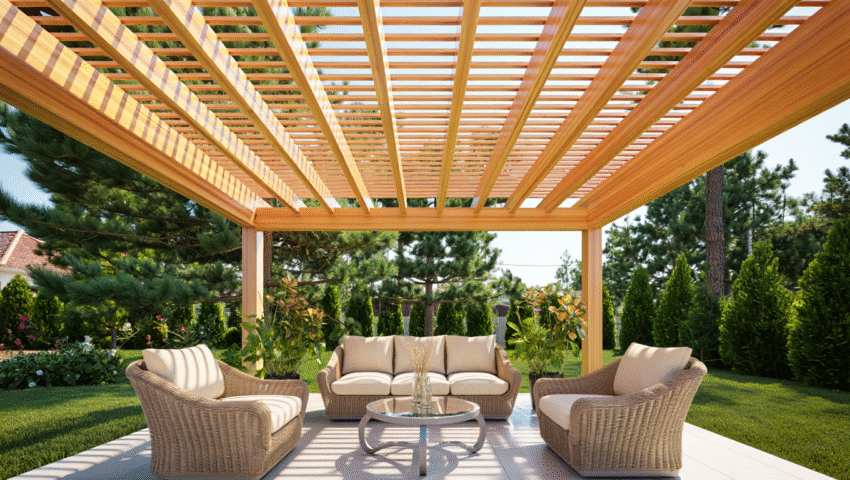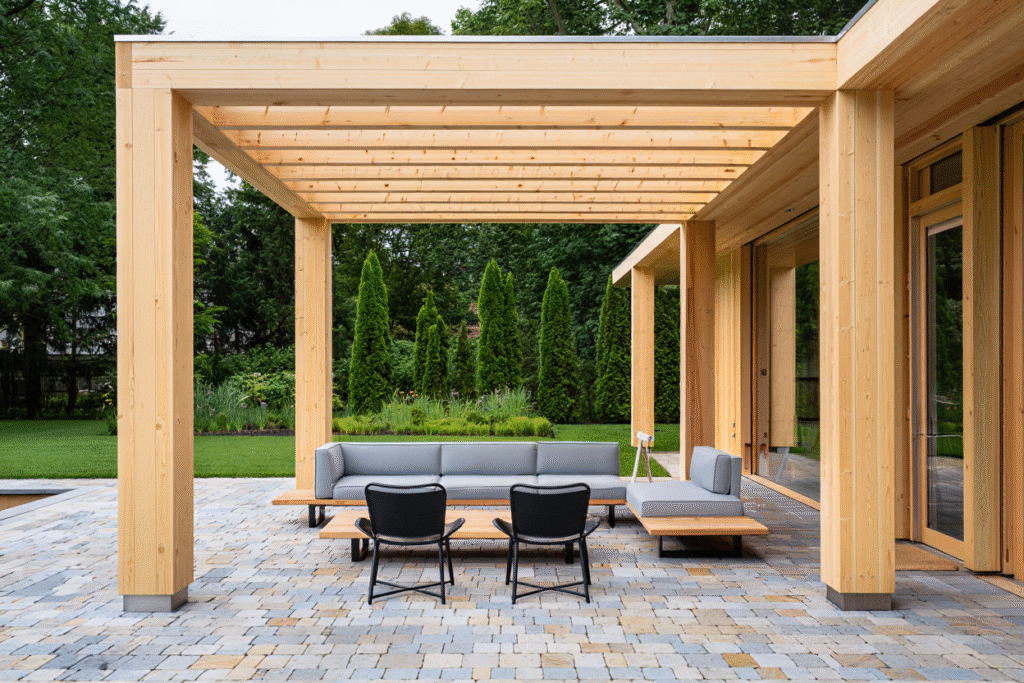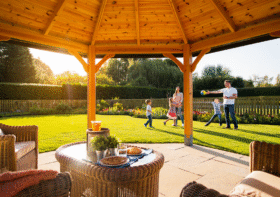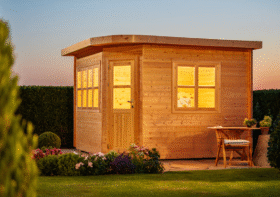Pine Pergolas: Stylish Outdoor Shade Solutions

Turning a backyard into a true oasis is a common homeowner dream. People want a beautiful, functional space for relaxation and entertainment. A key challenge is creating a comfortable area shielded from the harsh sun. This is where a well-chosen structure can transform a space, and a backyard pergola pine design is a popular choice for this. Thoughtful additions provide shade, define areas, and add significant visual appeal. Many homeowners are discovering that pine pergolas offer an ideal solution.
A pergola is an outdoor garden feature forming a shaded walkway or sitting area. It consists of vertical posts that usually support cross-beams and a sturdy open lattice. This lattice is often left open or covered with vines. These structures create an “outdoor room” feeling, blending architecture with nature. Understanding their design styles, installation process, and maintenance needs is crucial. This guide will explore everything you need to know about adding one to your home. To help you get started, we’ve prepared a comprehensive planning checklist, which you can download at the end of this guide.
Why Choose a Pine Pergola?
Pine is a fantastic material choice for outdoor structures for several reasons. It offers a winning combination of beauty, workability, and value. Many builders and homeowners gravitate towards it over other materials for their outdoor pine structures. The natural grain and warm tones of pine create a rustic yet elegant look. This aesthetic blends seamlessly into most garden and backyard settings. A backyard pergola pine structure offers a classic look that never goes out of style.
One of the biggest draws is its affordability compared to other woods like cedar or redwood. This makes it possible to build larger or more elaborate pine pergolas on a reasonable budget. Furthermore, pine is a softwood, which means it is easy to cut and shape. This workability simplifies the construction process for both professionals and DIY enthusiasts. The availability of pressure-treated pine also addresses concerns about outdoor durability. When treated, pine stands up well against rot and insect infestation.
Key reasons for selecting pine include:
- Cost-Effectiveness: Pine generally costs less than other popular woods like cedar or redwood. This allows for a greater return on investment.
- Natural Appearance: It has a light, natural color with a distinct grain pattern. This look complements outdoor greenery and landscapes beautifully.
- Ease of Customization: Pine accepts stains and paints very well. This allows for complete customization to match any home exterior or design theme.
- Sustainability: When sourced from managed forests, pine is a renewable resource. This makes it an environmentally conscious choice.
Choosing pine does not mean sacrificing quality. It is a smart decision that balances aesthetics, budget, and functionality. It provides a beautiful and sturdy frame for any outdoor living area.

Design Styles
Pine’s versatility allows it to fit into numerous architectural and landscape designs. From traditional to modern, there is a style to suit any preference. The design you choose should complement your home’s exterior and your personal taste. Think about the overall feeling you want to create in your outdoor space. Do you prefer clean, modern lines or a more classic, ornate look? These choices define your outdoor pine structures.
Traditional designs often feature more decorative elements. This can include notched ends on the rafters and beams, as well as curved braces. These styles work well with classic home designs like Colonial or Cape Cod. Modern or contemporary pine pergolas, on the other hand, emphasize simplicity. They feature clean lines, sharp angles, and minimal ornamentation. This minimalist approach suits modern, ranch, or transitional homes. Another popular option is the rustic or craftsman style. This design often uses larger, rough-hewn timbers to create a sturdy, natural look.
Considering the roof design is also important. A traditional flat-top pergola provides dappled sunlight. For more shade, you can add a retractable canopy or grow vines over the lattice. An arched or gabled roof adds a more dramatic architectural element. This style can make the structure feel more like a permanent, room-like addition. The right design choice will make your pergola feel like a natural extension of your home.
Choosing the Right Size
Selecting the right size for your pergola is critical for both function and aesthetics. A structure that is too small will look lost and fail to provide adequate space. One that is too large can overwhelm the yard and the house itself. The key is to find a balance that fits the scale of your property. Start by measuring the area where you plan to install the structure. Use stakes and string to outline the potential footprint.
Consider how you plan to use the space. Will it be a cozy nook for two, or an area for large family gatherings? This will determine the minimum square footage you need. A small, 8×8 foot pergola might be perfect for a quiet reading spot. For an outdoor dining area, you will likely need at least a 12×16 foot space. This size can comfortably accommodate a table and chairs. Many manufacturers of wooden pergolas USA offer a range of standard sizes. Custom sizing is also an option for unique spaces.
Here is a simple table to help guide your decision based on common uses:
| Pergola Size (Feet) | Common Use | Fits |
| 8 x 8 to 10 x 10 | Small seating area, garden accent | 2-3 chairs, small table, swing |
| 10 x 12 to 12 x 14 | Standard patio seating, small dining | Loveseat, chairs, coffee table |
| 12 x 16 to 14 x 18 | Outdoor dining, entertainment area | Dining table for 6-8, conversation set |
| 16 x 20 and larger | Large gatherings, multi-zone living space | Multiple seating areas, outdoor kitchen |
Remember to think about height as well. A standard pergola height is between 8 and 10 feet. This provides enough clearance without feeling cavernous. A properly sized pine pergola will enhance your backyard’s usability and visual harmony.
Measure your space twice, but measure your lifestyle three times. The best pergola fits both your yard and your social life.
Benefits for Outdoor Living
A pergola dramatically enhances the experience of outdoor living. It creates a defined, comfortable, and inviting area for a wide range of activities. This structure essentially adds a new room to your home without the walls. Across the market for wooden pergolas USA, enhanced lifestyle is a major selling point. A backyard pergola pine structure can also increase your property’s value. The immediate benefit is the creation of a designated zone for relaxation.
This defined space encourages you to spend more time outside. It can become a favorite spot for morning coffee, family dinners, or evening conversations. For those needing a dedicated workspace, these versatile outdoor rooms can even be adapted for professional use. A backyard pergola pine structure can also increase your property’s value.A study by Virginia Tech researchers (2018, USA) found that sophisticated landscape design can increase the perceived value of a home by 5.5 to 11.4 percent.
Here are some of the key benefits a pergola brings to your outdoor life:
- Defined Entertainment Space: It creates a focal point for your yard, perfect for hosting guests.
- Comfortable Shade: It provides relief from direct sunlight, making your patio usable even on hot days.
- Architectural Interest: A beautiful pergola adds vertical dimension and character to a flat, open yard.
- Support for Plants: It’s an ideal structure for growing climbing plants like wisteria or grapes.
- Improved Well-being: Spending more time outdoors has proven mental and physical health benefits.
Ultimately, a pine pergola improves your quality of life. It provides a beautiful setting to decompress, connect with nature, and make lasting memories with family and friends.
Durability of Pine Pergolas
Homeowners often ask about the longevity of pine in an outdoor setting. The durability of pine pergolas depends almost entirely on the type of pine used. Untreated pine is susceptible to rot and insect damage when exposed to the elements. However, modern treatment methods have made pine a reliable and long-lasting choice. The most common and effective method is pressure treatment.
During this process, chemical preservatives are forced deep into the wood’s fibers. This creates a powerful barrier against decay-causing fungi and wood-boring insects. This makes pressure-treated pine a robust material for years of outdoor exposure. These outdoor pine structures can easily last for decades with proper care. The standards for pressure-treating lumber used in wooden pergolas USA ensure a high level of protection. It is important to ensure the wood is rated for “ground contact” if the posts will be set in soil.
Mike Holmes, a renowned professional contractor, often advises: “Don’t just build to code; that’s the minimum. For something you want to last, like an outdoor structure, always use the best materials you can afford. Proper fasteners, like stainless steel or hot-dipped galvanized screws, are crucial to prevent rust and staining.”
This highlights the importance of using high-quality, corrosion-resistant hardware. These small details play a huge role in the overall lifespan of the structure.

Installation Process
The process for building outdoor pine structures involves careful planning, measuring, and assembly. Installing a pergola can be a manageable weekend project for a skilled DIYer. It can also be a straightforward job for a professional. Proper preparation is the most important step for a successful installation. Before starting, you must check local building codes and homeowner association rules. Some areas require a permit for structures of a certain size.
The installation begins with laying out the location of the posts. Precision here is essential for a square and stable structure. Once the post locations are marked, you need to prepare the footings. This usually involves digging holes and pouring concrete to create a solid anchor. The depth and diameter of the footings will depend on your local climate. This foundation is the most critical part of the build.
A Step-by-Step Installation Guide
After preparing the site and gathering your tools, you can begin the assembly. Following the manufacturer’s instructions for a kit, or your own detailed plans, is crucial. The process generally follows a logical sequence from the ground up.
- Set the Posts: Secure the posts to the concrete footings using metal anchors. Ensure each post is perfectly plumb (vertically level) using a level. This is a foundational step for all pine pergolas.
- Attach the Beams: Lift and attach the main support beams to the tops of the posts. These large boards run parallel to each other and will support the cross members. This step often requires a helper.
- Install the Rafters: Place the rafters, or joists, perpendicular to the support beams. Space them evenly according to your design to create the desired amount of shade. They are typically attached with screws.
- Add Bracing and Trim: Attach diagonal braces at the corners where the posts and beams meet. These add significant stability and prevent racking. Add any decorative end caps as the final touch to your backyard pergola pine project.
A level foundation is non-negotiable. The stability of your entire structure depends on getting the footings perfectly right from the start.
Cost Guide
The cost of a pine pergola can vary widely based on several factors. Size is the most significant driver of price. A larger structure requires more lumber and labor, increasing the expense. The complexity of the design also plays a role. Evaluating the cost of a backyard pergola pine project involves looking beyond the initial price tag. The choice between a DIY project and hiring a professional will also impact the budget.
A DIY kit is often the most budget-friendly option. These kits typically range from $800 to $3,000 for standard sizes. They come with all the pre-cut lumber and hardware needed. Building from scratch can sometimes be cheaper if you have the tools and skills. For those seeking wooden pergolas USA, prices for raw lumber will vary by region.
Hiring a professional to build a custom pergola will be the most expensive option. However, it also guarantees a high-quality result tailored to your exact specifications. Professionally installed pine pergolas can range from $3,000 to $10,000 or more. This cost includes consultation, design, materials, labor, and finishing. While the upfront cost is higher, it can save time and prevent costly mistakes.

Maintenance and Care
Proper maintenance is key to maximizing the lifespan of your pergola. Pine, even when pressure-treated, benefits from regular care. The primary goal is to protect the wood from moisture and sun exposure. These elements can cause the wood to weather, crack, or fade. A simple annual routine can keep your structure looking great for years. Given the varied climates where wooden pergolas USA are installed, a universal rule is consistent sealing.
The first step is a yearly cleaning. Use a mild soap and water solution with a soft-bristle brush to scrub away dirt and grime. A pressure washer on a low setting can also be effective. After cleaning, allow the wood to dry completely for a few days. This is an essential step for preparing the outdoor pine structures for sealing.
Once clean and dry, it’s time to apply a protective finish. This is the most important part of maintaining pine pergolas. You can use a clear water repellent, a tinted stain, or an exterior paint. A stain with UV protection is an excellent choice. It shields the wood from sun damage while allowing the natural grain to show. Apply a thin, even coat and reapply every one to three years.
An ounce of prevention is worth a pound of cure. A yearly cleaning and sealing will extend the life of your pine pergola by years, not months.
DIY vs Ready-Made Kits
Deciding between a full do-it-yourself (DIY) build and a ready-made kit is a major choice. Your decision should be based on your skill level, available tools, and time commitment. Both paths can lead to a beautiful and functional backyard pergola pine structure. A ready-made kit is the best option for those with basic carpentry skills. These kits remove the guesswork from the process.
Pergola kits come with all lumber pre-cut and pre-drilled. They also include all the necessary hardware and detailed instructions. This simplifies assembly significantly and reduces the chance of errors. Many companies that sell wooden pergolas USA offer a wide variety of kit styles and sizes. The primary advantage is convenience and a predictable outcome. The project can often be completed in a single weekend.
A full DIY build from scratch offers ultimate flexibility. This route allows you to create a completely custom design that perfectly fits your space. You have full control over the materials, dimensions, and details. However, this requires advanced carpentry skills and specialized tools. You will be responsible for creating plans and sourcing materials. While challenging, building a pine pergola from the ground up can be an incredibly rewarding experience.

Landscaping Ideas with Pergolas
A pergola serves as a fantastic anchor for a variety of landscaping designs. It can be the centerpiece of your backyard or a transitional element. Integrating plants with your pergola will create a cohesive and lush environment. The structure provides a perfect framework for vertical gardening. Climbing plants are a classic and beautiful addition. These additions truly bring outdoor pine structures to life.
Consider planting flowering vines like wisteria or climbing roses at the base of the posts. As they grow, they will weave through the lattice, providing natural shade. For a Mediterranean feel, grapevines are an excellent choice. The key is to choose plants that are well-suited to your climate.
Beyond plants, consider the flooring beneath your structure. A paver patio or wooden deck can define the space and provide a solid surface. This “floor” helps to reinforce the feeling of an outdoor room. You can also use landscape beds with shrubs around the perimeter of the pergola. A paver patio, stone floor, or wooden deck can define the space beneath your backyard pergola pine. This helps to soften the edges and integrate the pine pergola into the garden.
Lighting and Decor Tips
The right lighting and decor will transform your pergola into a magical evening retreat. Outdoor lighting extends the usability of the space well past sunset. It also adds ambiance and improves safety. There are many weather-resistant lighting options available. String lights, also known as bistro lights, are a popular and affordable choice. They create a warm, festive glow perfect for entertaining.
For more targeted lighting, you can install spotlights or uplights. Aim them at the posts or up into the rafters to highlight the structure’s details. You can also hang outdoor pendants from the center of the pergola. Solar-powered lights are a great option for an easy, wire-free installation. As a leading designer advises, adding layers makes the space feel complete.
Breegan Jane, a celebrated interior designer, suggests: “Treat your outdoor space like an indoor one. Layering is key. Use a large outdoor rug to define the area, add comfortable seating, and introduce texture with pillows and throws. This makes the space feel intentional and inviting.”

FAQ
How do you anchor a pine pergola?
A pine pergola must be securely anchored to the ground to withstand wind. The most common method is to use concrete footings. You dig holes below the frost line, pour concrete, and set metal post brackets into it. Once cured, the wooden posts are attached to these brackets. For installation on an existing patio, you can use specialized surface-mount anchors.
Why is pressure-treated pine green?
The greenish tint on pressure-treated pine comes from the copper in the chemical preservative. The copper is the primary component that protects the wood from rot and insects. This color will fade to a honey-brown and eventually a silvery-gray over time with sun exposure.
What is better, a pine pergola or a cedar pergola?
Both pine and cedar are excellent choices with different strengths. Cedar has natural resistance to rot and insects. It also has a rich color. However, cedar is significantly more expensive. Pressure-treated pine pergolas offer comparable durability at a much lower price point. The best choice depends on your budget.
How much weight can a pine pergola hold?
A well-constructed pine pergola is very strong. The weight capacity depends on the size of the lumber, the span of the beams, and the design. A standard pergola is designed to support its own weight and climbing plants. Many can also support items like swings, but it is crucial to ensure the design includes extra reinforcement.
Watch this detailed guide on building a pressure-treated pine pergola — a perfect example of putting our tips into practice. The key highlight is creating a stylish and functional outdoor space using a pine pergola.
A well-chosen pergola can be the single most impactful addition to a backyard. It provides shade, structure, and a beautiful focal point. By offering a blend of beauty, affordability, and versatility, pine pergolas stand out as an exceptional choice. They create a welcoming space to relax, entertain, and enjoy the outdoors.
From understanding the benefits of treated pine to exploring different design styles, you now have the knowledge to move forward. Whether you choose a kit or a custom build, the result is a valuable addition to your home. For those seeking wooden pergolas USA, investing in one of these wonderful outdoor pine structures is not just building a shady spot. You are creating a new lifestyle hub for your family to enjoy.
Before you begin your project, proper planning is the key to success. To make the process easier, we have created a detailed Pine Pergola Planning & Building Checklist. This practical guide will walk you through every step, from measuring your space and choosing materials to final safety checks, ensuring you don’t miss a single detail. Download your free copy to stay organized and build with confidence.



Leave a Reply